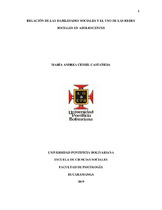Mostrar el registro sencillo del ítem
Relación de las habilidades sociales y el uso de las redes sociales en adolescentes
| dc.contributor.advisor | Director. Muñoz Rondón, Tatiana Milena | |
| dc.contributor.author | Castañeda Cediel, María Andrea | |
| dc.coverage.temporal | 2019 | |
| dc.date.accessioned | 2020-12-01T21:26:08Z | |
| dc.date.available | 2020-12-01T21:26:08Z | |
| dc.date.issued | 2019-05 | |
| dc.identifier.uri | http://hdl.handle.net/20.500.11912/6873 | |
| dc.description | 62p.: (pdf); il; gráficas; anexos. | spa |
| dc.description.abstract | El objetivo del estudio fue analizar la relación del uso de las redes sociales con el desarrollo de las habilidades sociales en estudiantes adolescentes de los grados décimo y once de dos instituciones educativas públicas del Área Metropolitana de Bucaramanga. La metodología utilizada fue de orden cuantitativo, con un diseño transeccional o transversal de alcance correlacional. La muestra total seleccionada fue de 174 estudiantes, cuyas edades oscilaron entre los 14 y 18 años de edad. Se aplicó el Cuestionario de adicción a las redes sociales (ARS, 2014) y la Batería de socialización (BAS — 3, 1987) con el fin de identificar la relación existente entre estas y correlacionar cada uno de sus factores. Se encontró que los adolescentes encuestados presentan un uso excesivo de las redes sociales, buena consideración con los demás, un nivel medio de liderazgo, otro medio-bajo de autocontrol y sinceridad, y uno bajo de retraimiento social y ansiedad social/timidez. Adicionalmente, se evidenció que existe una relación significativa y negativa entre el uso excesivo de las redes sociales con el autocontrol; sin embargo, se aumenta la sinceridad, la cual es entendida como el inconformismo social, desconocimiento y desacatamiento de normas sociales. Por último, es fundamental entrar a implementar programas estratégicos en los cuales se pueda fomentar el autocontrol, la consideración con los demás y el liderazgo. | spa |
| dc.description.abstract | The goal of the study was to analyze the relation of the social networks with the development of the social skills in teenage students from tenth and eleventh course that belong to public schools of the metropolitan area of Bucaramanga. The methodology applied was of quantitative order with a transactional design or across the correlate scope. The total sample was of 174 students, who the average age was 16. The social networks addiction test (ARS,2014) and the socialization battery (BAS-3,1987) were applied with the aim of identify the relation that exist between that ones and correlate each of their factors. We found that the teens that were part of the pool present an excessive use of the social networks, a good consideration with others, a middle level of leadership, a low-middle level of self-control and sincerity, a less level of social retraction and anxiety or social shyness. Also, we evidenced that exist a significative relation between the excessive use of the social networks and self-control in a wrong way, but nevertheless the sincerity is increasing, and this behavior is understand by the reason of the social nonconformity, ignorance and disrespect of social rules. Finally, is fundamental go on and implement strategic programs where we can foment the self-control, thinking in the others wellness and the leadership. | eng |
| dc.format.mimetype | application/pdf | |
| dc.language.iso | spa | |
| dc.publisher | Universidad Pontificia Bolivariana | spa |
| dc.rights | Attribution-NonCommercial-NoDerivatives 4.0 International | * |
| dc.rights.uri | http://creativecommons.org/licenses/by-nc-nd/4.0/ | * |
| dc.subject | Adolescentes | spa |
| dc.subject | Redes sociales | spa |
| dc.subject | Habilidad social | spa |
| dc.subject | Adictos a internet | spa |
| dc.title | Relación de las habilidades sociales y el uso de las redes sociales en adolescentes | spa |
| dc.type | Trabajo de grado | spa |
| dc.publisher.department | Escuela de Ciencias Sociales | spa |
| dc.publisher.program | Psicología | spa |
| dc.type.hasVersion | publishedVersion | spa |
| dc.description.sectional | Bucaramanga | spa |
| dc.description.degreename | Psicólogo | spa |
Ficheros en el ítem
Este ítem aparece en la(s) siguiente(s) colección(ones)
-
Trabajos de grado [6698]
Monografías, artículos, informes, proyecto de grado


